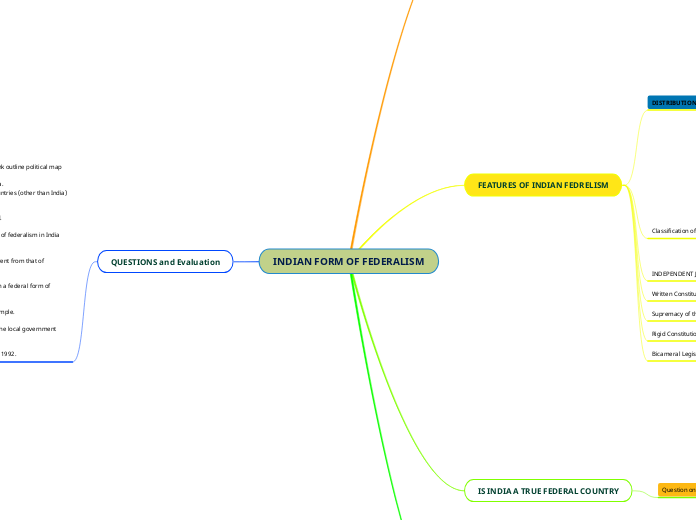
Federalism is a system of government in which the power is divided between a central authority and various constituent units of the country. Usually, a federation has two levels of government. One is the government for the entire country that is usually responsible for a few subjects of common national interest. The others are governments at the level of provinces or states that look after much of the day-to-day administering of their state. Both these levels of governments enjoy their power independent of the other.
ACTORS
CENTER GOVT
STATE GOVT
LOCAL GOVERNING BODY OR PANCHAYATS
DISTRIBUTION OF POWERS
UNION LIST
Union List includes subjects of national importance such as defence of the country, foreign affairs, banking, communications and currency. They are included in this list because we need a uniform policy on these matters throughout the country. The Union Government alone can make laws relating to the subjects mentioned in the Union List.
STATE LIST
State List contains subjects of State and local importance such as police, trade, commerce, agriculture and irrigation. The State Governments forest, trade unions, marriage,
adoption and succession. Both the Union as well as the State Governments can make laws on the subjects mentioned in this list. If their laws conflict with each other, the law made by the Union Government will prevail.
CONCURRENT LIST
What about subjects that do not fall in any of the three lists? Or subjects like computer software that came up after the constitution was made? According to our constitution, the Union Government has the power to legislate on these ‘residuary’ subject
Classification of States
3 Types Of Units
SPECIAL CATEGORY STATES
Union Territories
Normal States
INDEPENDENT JUDICIARY
Written Constitution:
Supremacy of the Constitution:
Rigid Constitution:
Bicameral Legislature:
Question on INDIAN FEDERAL STRUCTURE
UNITARY IN NATURE
Single Citizenship
A Strong Centre:
Single Constitution for Union and States
Centre Can Change Name and Boundaries of States:
Single Unified Judiciary
Unitary in Emergencies:
Common All-India Services:
Inequality of Representation in the Council of States:
Appointment of Governor by President
Appointment of the High Court Judges by the President:
The Office of the Comptroller and Auditor-General:
Centralized Electoral Machinery
FEDERAL STRUCTURE is a part of BASIC STRUCTURE.
Federal but some unitary features
Quassi Federal
1. Locate the following States on a blank outline political map of India:
Manipur, Sikkim, Chhattisgarh and Goa.
2. Identify and shade three federal countries (other than India) on a
blank outline political map of the world.
3. Point out one feature in the practice of federalism in India that is
similar to and one feature that is different from that of Belgium.
4. What is the main difference between a federal form of government
and a unitary one? Explain with an example.
5. State any two differences between the local government before and
after the Constitutional amendment in 1992.